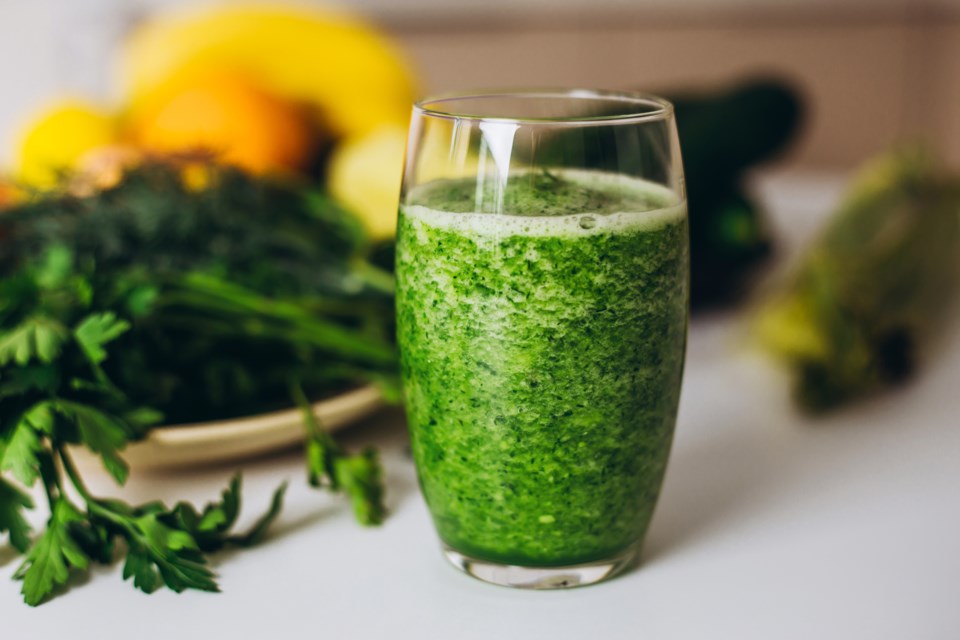What are the benefits and differences between juicing and blending smoothies? Just like Star Trek versus Star Wars fans, people tend to be loyal to one or the other. I am a Trekkie and I like my smoothies.
Digestion is a two-part process: physical (grinding) and chemical (digestive acids). The digestive benefit to getting our nutrients from a smoothie or juice is that the physical part of the digestion is already done.
Apparently juicing raw veggies is no healthier than eating whole fruits and vegetables but I disagree, as it makes sense that there would be a higher concentration of vitamins per ounce in the juiced veggies and fruit than in the fresh ones, and the liquid contains most of the vitamins, minerals and phytonutrients. Also, one would probably juice more veggies than they would pile on their plate and can also consume more of a variety of veggies and fruit by juicing than they may commonly eat. I hate eating celery but could probably handle it juiced with other fruits & veggies. And anyone can plug their nose and down it goes if they really put their mind to it (or add an apple to sweeten the concoction).
The body may be able to better absorb the juice than the whole fruit or vegetable and many believe that juicing boosts the immune system, reduces the risk of getting cancer, helps with digestion, fights inflammation, is an antioxidant and can remove toxins from the body.
If one has IBS or other digestive issues, juicing may be a good option as it is easier to digest than the fibre rich whole food or smoothie. When juicing, make sure not to make too much at once as harmful bacteria grow quickly in fresh juice.
An argument against juicing is that fibre is taken out in the process. When I used to do a lot of juicing, I would remove the pulp left over in the juicer, mix it with some apple juice and dehydrate it to make fruit bars. This was fun when my kids were little.
Another drawback to juicing is that one may not get enough calories if too much of their diet is juiced, causing the metabolism to slow down. Or if the juice is high in fruit, they may be getting too much glucose, which could cause blood sugar spikes and pre-diabetes. Juicing has great short-term benefits if the ingredients are mainly veggies but it is not recommended for long-term health. One must also be aware of contra-indications with certain medications: grapefruit increases the absorption of many meds, kale and other leafy greens are rich in vitamin K which can counter the effects of blood thinners. Some potassium rich foods that are commonly juiced can cause problems if you have kidney issues. It is advised to talk to your doctor &/or pharmacist before starting a juice cleanse if you have existing health issues, as you will be consuming high doses of concentrated nutrients. Also, please use organic fruits and veggies if you can, or make sure to wash well and peel them so you aren’t consuming pesticide residue.
If the digestive system is in working order, blending is a great option because of the beneficial fibre (which also helps one feel full). Fibre also helps regulate blood sugar so smoothies are a healthier option for people who are concerned about diabetes.
I prefer to make smoothies because they are a great way to start my day. Breaking my night-time fast (break-fast) with a meal that is easy to digest and full of nutrients makes sense to me. I can also add a lot more than fruits and veggies into them. My smoothies contain fermented food (homemade kefir), which is great for gut health, coconut water, veggies like spinach or kale (which I would never get my kids to eat on their own), protein and EFA rich omegas like chia seeds, hemp hearts, flax seed and avocado, anti-oxidant rich berries, frozen watermelon and banana, my turmeric-ginger elixir, additional protein powder, extra fibre and green powder.
Juicing may deliver a whopping amount of vitamins from the fruits and veggies but is lacking in healthy fats, proteins and fibre. Try to avoid the juicing fad (where you eat nothing else) unless you have discussed it with your doctor and naturopath. Another reason I prefer blending a smoothie rather than juicing is that cleaning my blender is a lot less mess than cleaning all the parts of a juicer.
Anyone who wants my smoothie recipe, feel free to send me an email.
Claire Nielsen is a health coach, author, public speaker and founder of www.elixirforlife.ca. The information provided in the above article is for educational purposes only and is not a substitute for professional health and medical advice. Please consult a doctor or healthcare provider if you're seeking medical advice, diagnoses and/or treatment.



